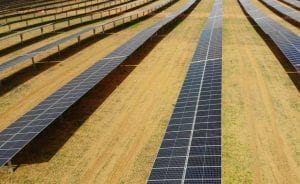Byron shire is to become the first council in Australia to trial “virtual net metering” in what could presage a dramatic change in the way electricity is produced, but also in the role that networks play in the distribution of that electricity.
Virtual net metering – also known as peer-to-peer trading – allows the excess production from the solar array of one building to be credited against the consumption of another building, as this simple graphic shows.
In the case of Byron shire, it could mean a large rooftop installation going on top of its sporting centre, which has ample roof space and not a lot of consumption, and the excess capacity credited to the neighbouring sewage plant, which has little roof space for a solar array, but has heavy energy needs.
Under current rules, the excess solar output from an array on the sporting centre has to be sold back to the grid, for a payment of just 6c/kWh in NSW, if you are lucky (the payment is actually voluntary). But that output might be sold back by the retailer to the sewage plant at full commercial rates, which are likely more than 5 times that amount.
Virtual net metering or peer to peer trading has been advocated by many as one means where network operators could dodge the death spiral. Rather than encouraging users to use battery storage to save the excess energy and perhaps go off-grid, allowing virtual net metering means their poles and wires still have some skin in the new energy architecture.
Byron mayor Simon Richardson says the shire made just that proposal to the local network operator Essential Energy.
“We wrote a letter to Essential Energy, and we said the way we see it you have a death spiral on your economic model, you are increasingly expensive, and as solar and battery storage costs come down more and more people might leave the grid,” Richardson told a solar energy forum on the weekend. And that means rising prices for those remain and more people leaving the grid.
“What we want to do is use the poles and wires, so you can keep the customers, although you are going to have to charge them far less. They actually wrote back and agreed with economic business model, and invited us to come down to Sydney and talk.”
Richardson says the new initiative is a “massively game changing” – as it would allow not just councils to credit excess production from one building to another building, but also businesses- such as in Byron Bay’s industrial estate, to pool resources on one suitable roof and share in the benefits.
“The ramifications are massive,” he said. Indeed, such initiatives have been proposed by the likes of Geogf Bragg, from the Solar Energy Industry Association, who noted last year that some businesses chose to switch off their solar arrays on weekends, rather than “let the energy company get it for nothing”.
Bragg said peer to peer trading, as he calls it, allows the network owner to “clip the ticket” for transferring the energy and allow anyone with a smart meter to join the market as a buyer or seller. Customers could set their buy and sell rates for energy for distributed energy via an online portal. Bragg says it’s not much more than an accounting exercise.
Interestingly enough, Reposit Power is to trial a system that will allow households with solar and storage to trade energy with each other and with the grid, in yet another indication of how the relationship between networks, retailers and consumers will change.
And some network operators, such as those in South Australia, agree that this might be the future – seeing a time when local communities would be largely “off grid”, and would generate and sell electricity among themselves. Networks would have a role as the mechanism to transport that electricity, but at SA Power Networks chief Ron Stobbe says, the future is not so clear for conventional retailers or centralised generators.
The virtual net metering is one of a number of ground-breaking initiatives going in the Byron shire and surrounding areas. Last week, the council formally ratified a plan to aim for “zero emissions” within 10 years, implementing a plan devised by Beyond Zero Emissions that would encompass energy, transport, buildings and land use.
Byron and surround regions are also about to host the launch of Australia’s first community-owned energy retailer, and neighbouring towns Mullumbimby and Lismore are aiming to source 100 per cent of their energy needs from renewable energy within 10 years.
The details of Byron’s virtual net metering trial are to be formally announced on Tuesday, when NSW environment minister Rob Stokes will unveil a $200,000 payment grant. Richardson, a Green, was effusive in his praise for Stokes, a Liberal, as someone “who absolutely gets what we are talking about”.
“He knows and is passionate about it, we need to get champions of the industry in important positions. We need to support any politicians that gets what we trying to push for, resist those who don’t, and advocate to those who are on the fence to get off the fence and join this industry.”









